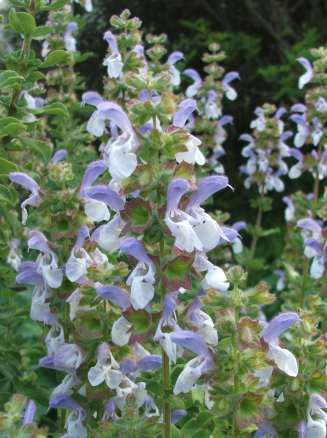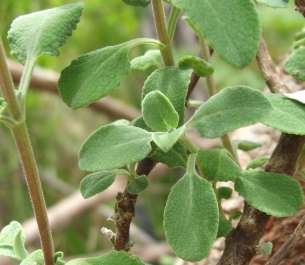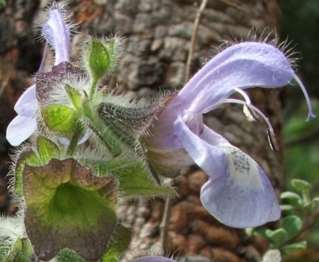Salvia africana
Salvia africana L. (= Salvia africana-caerulea L.)
Family: Lamiaceae
Common names: blue African sage, blue sage, wild sage, African sage, purple sage (Eng.); blousalie, bloublomsalie, Afrikaansesalie, perdesalie, wildesalie (Afr.)
Introduction
Salvia africana is a decorative, aromatic shrub with medicinal properties. Keep it neat and pruned and it will reward you with flowers almost all year round.

Description
Description
Salvia africana is a soft, greyish, hairy, much-branched shrub up to 2 m tall. The leaves are greenish on the upper surface, covered with grey hairs and dotted with glands on the lower surface, strongly aromatic, simple, opposite, obovate (egg-shaped but broader towards the tip) and sometimes toothed.

Flowers are produced from midwinter to midsummer (June to January) peaking in spring to early summer (Aug.-Dec.), in whorls, crowded at the tips of the stems. The corolla is two-lipped, the lips roughly equal in length; the upper lip is blue to bluish-purple or pinkish and hooded; the lower one is usually white in the centre with darker spots, and is turned down at the edge, giving the impression of a gaping mouth.
The style is long, slender and curved, and sticks out beyond the hooded upper lip. The stamens are strangely shaped. The filament of each stamen is attached to one side of the lower part of the corolla tube. A cross-piece that is hinged so that it can move up and down is attached at the top end of the filament. This cross-piece carries the anther at one end and a 'pedal' at the other.
The 'pedal' is in fact the other half of the anther, transformed into a structure that a visiting bee has to press on as it probes for nectar, causing the hinged anther to move down and deposit pollen on the back of the bee. The calyx is funnel-shaped, dotted with glands and covered in long, silky grey hairs, green with pinkish purple tips. It persists long after the flower has dropped and enlarges at the fruiting stage, becoming thin, light and papery by the time the seeds are mature.
The fruit consists of four 1-seeded, small, rounded nutlets that are formed at the base of the flower, inside the calyx. They remain attached at the base of the calyx after the flower drops, falling out when mature.

Conservation Status
Status
Salvia africana is not threatened.
Distribution and habitat
Distribution description
Salvia africana is found on sandy slopes and flats from Namaqualand in the Northern Cape to the Cape Peninsula and Caledon in the Western Cape. It grows in fynbos.
Derivation of name and historical aspects
History
Salvia comes from the Latin, salvere, meaning to save or heal, referring to the healing properties of these plants. The species name, africana, means of or from Africa,
This species has for many years been known as Salvia africana-caerulea, however, according to the rules of botanical nomenclature, hyphenated names are illegitimate. The current or 'new' name was also given by Linnaeus a few years after he coined the original name, and is now the legitimate name. Caerulea means blue.
Salvia africana was one of the first plants to be used medicinally by the Dutch at the Cape, who used it instead of sage, Salvia officinalis, which has been used and esteemed as a medicinal plant, applied for all ills, at least since the days of ancient Greece and Rome. The reputation of our Salvia as a medicinal plant may be why it was cultivated in the Amsterdam medical garden by about 1710 and in the Chelsea Physic Garden by about 1760.
Ecology
Ecology
Salvia africana is pollinated by bees and the flower is adapted to assist in pollination-see the description above to recap the structure of the flower. The bottom petal is a platform for the bee to land on. As it probes for nectar, it presses against the ‘pedal’, which causes the hinged anthers to move down and deposit pollen on the back of the bee, while the curved stigma collects pollen that it has already picked up from other flowers it visited previously.
The hooded upper petal protects the anthers, e.g. from rain and dew. By the time the seeds are ripe, the calyx is dry, papery and light, assisting in the dispersal of the seeds by being easily blown about by the wind.
Uses
Use
Many African salvias, including Salvia africana have long been used by the people of Africa as medicinal plants and to flavour food. A remedy made by mixing S. africana tea with Epsom salts and lemon juice was used by the early settlers in South Africa to treat stomach troubles, including colic, diarrhoea, flatulence, heartburn, gripes and indigestion.
It was also given to cows after calving to help in the expulsion of the placenta. The Khoisan people used S. africana to treat coughs, colds and women's ailments. The leaves, mixed with those of Ballota africana (kattekruie) were also used to treat fevers and measles.
Margaret Roberts recipe for sage tea is to pour one cup of boiling water over one tablespoon of fresh leaves, allow to draw for 5 minutes, sweeten with honey and add a slice of lemon for taste. To ease a cough, including whooping cough, sip a little frequently. To treat colds, flu and chest ailments and for painful or excessive menstruation, drink half a cup four times a day.
The tea is also an excellent gargle for sore throats and night coughing. Even chewing a fresh leaf will ease a sore throat and help restore a lost voice. This tea can also be used externally as a mildly antiseptic wash. A stronger brew using one tablespoon of fresh leaves chopped into one tablespoon of honey and two tablespoons of lemon juice makes a soothing cough mixture for a persistent cough: take one tablespoon every half hour until the cough eases.
Salvia africana is an excellent substitute for the ordinary cultivated sage, Salvia officinalis.

Growing Salvia africana
Grow
Salvia africana is easy to grow and a rewarding garden shrub, adding texture, contrast and colour to the garden. Grow it in full sun in well-drained soil. Water well until it is established but take care not to over-water, as, like most sages, it does not like to be waterlogged. Cut back after flowering to keep it neat and vigorous, and it will bloom nearly all year round. It can be grown in low rainfall areas and is a good choice for the water-wise and fynbos garden and is a must for the herb garden. It tolerates frost (-1 to -5 o C/20 to 30 o F) and does well on the Highveld.
Propagate Salvia africana by seed or cuttings. Cuttings give the best results. Cuttings from new growth near the base of the plant taken in spring or early summer root very easily. The newly rooted plants respond well to regular feeding with an organic fertilizer.
Seed can be sown in autumn or spring to early summer. Use well-drained soil and keep moist. As soon as the seedlings are strong enough to handle, transfer them to a single pot. After a few more weeks they are ready for planting into the garden. The seedlings respond well to organic fertilizer and pinching the tips will encourage bushy, vigorous growth and more flowers.
References
- Goldblatt, P. & Manning, J. 2000. Cape plants. A conspectus of the Cape flora of South Africa. Strelitzia 9. National Botanical Institute, Pretoria & Missouri Botanical Garden, Missouri.
- Jackson, W.P.U. 1990. Origins and meanings of names of South African plant genera. University of Cape Town Printing Dept, Cape Town.
- Manning, J., Goldblatt, P. 1996. West coast. South African Wild Flower Guide 7. Botanical Society of South Africa, Cape Town.
- Roberts, M. 1990. Indigenous healing plants. Southern Book Publishers, Halfway House, South Africa.
- Smith, C.A. 1966. Common names of South African plants. Memoirs of the Botanical Survey of South Africa No. 35.
- Van Rooyen, G. & Steyn, H. 1999. Cederberg. South African Wild Flower Guide 10. Botanical Society of South Africa, Cape Town.
Credits
Monwabisi Zelanga and Alice Notten
Kirstenbosch National Botanical Garden
January 2008
Updated February 2019
Plant Attributes:
Plant Type: Shrub
SA Distribution: Northern Cape, Western Cape
Soil type: Sandy
Flowering season: Spring, Early Summer, Winter
PH: Acid
Flower colour: Blue, White
Aspect: Full Sun, Morning Sun (Semi Shade), Afternoon Sun (Semi Shade)
Gardening skill: Easy
Special Features:
Horticultural zones











Rate this article
Article well written and informative
Rate this plant
Is this an interesting plant?
Login to add your Comment
Back to topNot registered yet? Click here to register.